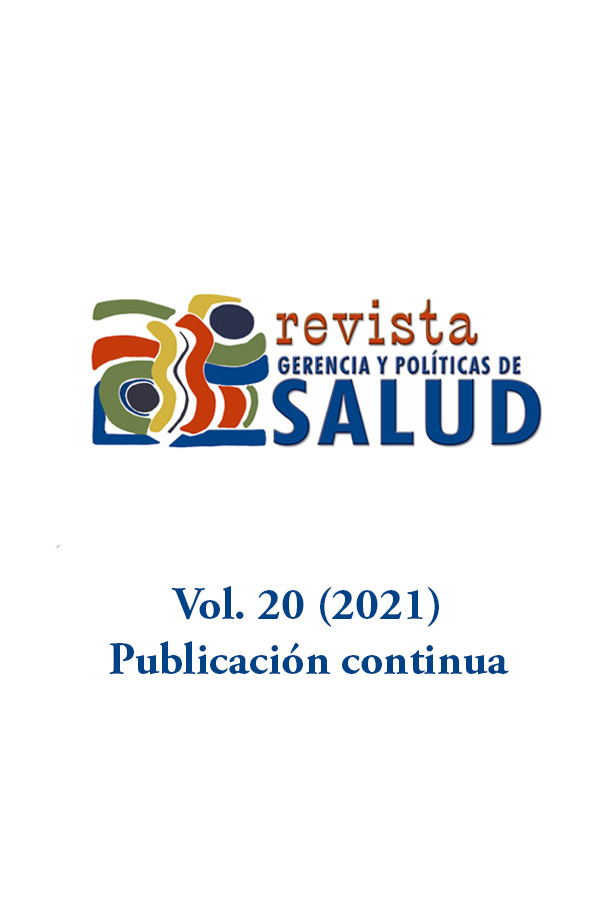Abstract
Objective. Describe and compare the behavior of overtreatment based on three multivariate models, and identify the demographic, socioeconomic, clinical, and administrative conditions that could be associated with its prevalence in an institution providing health services. Materials and methodology. Cross-sectional design on the census of medical care recorded during a year. Demographic, socioeconomic, clinical, and administrative variables were studied. In the absence of agreement on the concept of overtreatment three different scenarios were studied for three, eight and ten or more consultations during the study period. The prevalence of the variables was measured and bi- and multi-variate associations were established based on the Odds Ratio (OR). Results. A greater number of consultations were statistically associated with being a woman, over 60 years of age, having a partner, attending scheduled preventive consultations, consulting in the first half of the year, having a diagnosis of diseases of the musculoskeletal system or connective tissue, and having received four or more days of temporary disability in the year. Some effect sizes were small, and their practical utility may be limited. Conclusions. Understanding overtreatment requires considering individual conditions, the health system, the socio-cultural context, and current legislation. It is recommended that quality audits and qualitative studies be carried out that explore the patients’ perceptions about their health status and their use of the services.
Giraldo MH, Rincón MH, Uribe GE, Cardona D. Costos de la atención en salud en pacientes hiperfrecuentadores de tres centros de salud. Medellín, 2007-2008. Rev Salud Pública de Medellín. 2010;2:12. http://bdigital.ces.edu.co:8080/repositorio/handle/10946/968
Rodríguez C, Cebrià J, Corbella S, Segura J, Sobreques J. Rasgos de personalidad y malestar psíquico asociados a los pacientes hiperfrecuentadores de consultas de Atención Primaria. Medifam. 2003;13(3):23-30. http://scielo.isciii.es/scielo.php?script=sci_arttext&pid=S1131-57682003000300003&lng=es&nrm=iso
Cadalso SF, García-Martínez J. Perfil psicológico del paciente hiperfrecuentador en un centro de atención primaria. Acción Psicológica. 2012;9(2):35-46. http://dx.doi.org/10.5944/ap.9.2.4102
Llorente S, López T, García L, Alonso P, Muñoz P, Alonso M. Perfil del hiperfrecuentador de un centro de salud. Aten Primaria. 1996;17(2):100-107. https://doi.org/10.5944/ap.9.2.4102
Rojas VC, Molinet JR, Costa AMP, Rovira G, Gutiérrez AMR, Antolín LS, et al. Factores sociales asociados a la hiperfrecuentación en centros de atención primaria de salud: un estudio desde el trabajo social sanitario. Rev de Investigaciones en Intervención Social. 2011;2:27. https://dialnet.unirioja.es/servlet/articulo?codigo=5304691
Aguilar-Jiménez E, Vicente-Herrero M, López-González Á. Hiperfrecuentación en incapacidad temporal en una empresa socio-sanitaria de las Islas Baleares (España). Variables relacionadas. 2017;26(1):1-83. http://scielo.isciii.es/pdf/medtra/v26n1/1132-6255-medtra-26-01-00062.pdf
Rodriguez-Lopez M, Arrivillaga M, Holguín J, León H, Ávila A, Hernández C, et al. Perfil del paciente hiperfrecuentador y su asociación con el trastorno ansioso depresivo en servicios de atención primaria de Cali, Colombia. Rev Peru Med Exp Salud Pública. 2016;33(3):478. https://doi.org/ 10.17843/ rpmesp.2016.333.2335
Rodríguez-López MR. Abordaje del paciente hiperfrecuentador de servicios en atención primaria: un acercamiento desde la teoría. Rev Gerenc Polit Salud. 2012;11(22):43-55. https://doi.org/10.11144/Javeriana.rgsp11-22.aphs
Cadalso SF, García-Martínez J. Perfil psicológico del paciente hiperfrecuentador en un centro de atención primaria. Acción Psicológica. 2012;9(2):35-46. http://dx.doi.org/10.5944/ap.9.2.4102
Rincón-Hoyos HG, López MRR, Ruiz AMV, Hernández CA, Ramos ML. ¿Sería útil la depuración de los trastornos mentales comunes en pacientes hiperfrecuentadores de servicios de salud en cuidado primario? Rev Colomb Psiquiatr. 2012;41(4):853-866. https://doi.org/10.1016/S0034-7450(14)60051-2
Hodgson P, Smith P, Brown T, Dowrick C. Stories from frequent attenders: A qualitative study in primary care. Ann Fam Med. 2005;3(4):318-323. https://doi.org/10.1370/afm.311
Rubio MM, Adalid CV, Cordón FG, Solanas PS, Masó DC, et al. Overattendance at primary care: A study of psychosocial factors. Aten Primaria. 1998;22(10):627-630. https://pubmed.ncbi.nlm.nih.gov/9931557/
Arroyo E, Auquer F, Buñuel J, Rubio M, Adalid C, Cordón F, et al. Hiperfrecuentación en atención primaria: estudio de los factores psicosociales. Aten Primaria. 1998;22(10):627-630. https://www.elsevier.es/es-revista-atencion-primaria-27-articulo-hiperfrecuentacion-atencion-primaria-estudio-factores-14986
Sandín-Vázquez M, Conde-Espejo P. Hiperfrecuentación: percepción de los profesionales de atención primaria sobre la influencia de factores sociales y de organización del entorno sanitario. Rev Calid Asist. 2011;26(4):256-263. https://doi.org/10.1016/j.cali.2011.03.006
Arandia IW. Somatización e hiperfrecuentación. Rev Médica Paz. 2013;19(1):40-52. http://www.scielo.org.bo/scielo.php?script=sci_arttext&pid=S1726-89582013000100007&lng=es&nrm=iso
Fernández C, Aguilar JM, Romero R, Rivas A, Fuentes ME, González JJ. Hiperfrecuentación en atención primaria e hiperfrecuentadores en Urgencias. Aten Primaria. 2018;50(4):222-227. https://doi.org/10.1016/j.aprim.2017.02.011

This work is licensed under a Creative Commons Attribution 4.0 International License.
Copyright (c) 2021 John Jairo Morales Botero, Silvana Montoya Montoya Sierra, Rubén Darío Gómez-Arias


